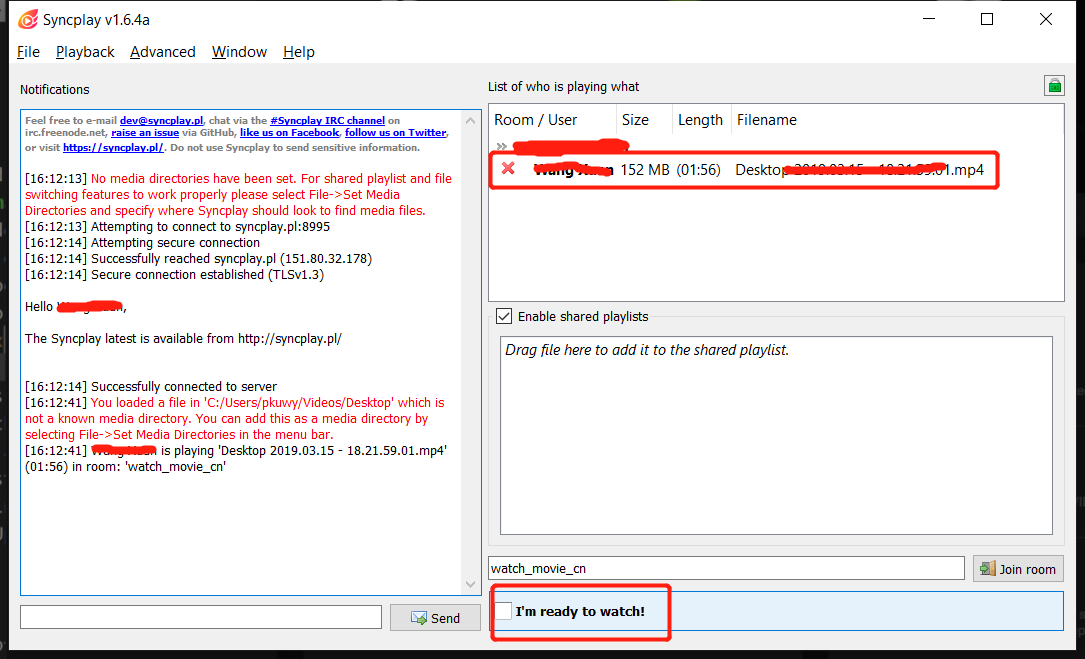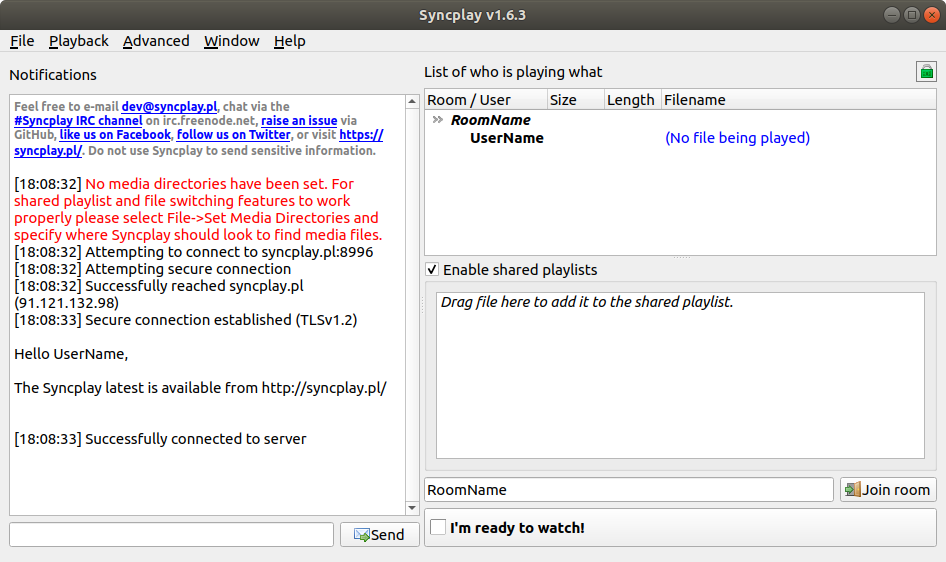After months of work, here comes another behemoth of a release, this time with over 30 major improvements and tons of fixes.
At more than 500 pull requests merged between the server and the web client, Jellyfin 10.6.0 brings an incredible number of new features, improvements and bug fixes. It's a huge release and we have a lot to cover, so let's get to it!
Other services have recently launched various ways to view your content together with friends. With the current global situation, it makes a lot of sense, and Jellyfin isn't lagging behind.
Apr 11, 2021 Syncplay might be flagged as suspicious by some anti-malware systems simply because it is niche software downloaded from the Internet but as we are open source anyone can audit our code if they wish to do so. Pausing, unpausing and seeking are synchronized over the Internet, giving everyone playing the same file in the same virtual room a shared viewing experience. Use alongside VoIP software, e.g. Mumble or Skype. Syncplay is a Video application like Animiz, Online TV, and CherryPlayer from Syncplay Team. It has a simple and basic user interface, and most importantly, it is free to download. Syncplay is an efficient software that is recommended by many Windows PC users. Syncplay is a very fast, small, compact and innovative Open Source Video for Windows PC.
Welcome to the era of “Living in the moment”- digitally. For the past ten years, social media and social networking has changed. Everything is done in re. Client/server to synchronize media playback on mpv/VLC on multiple computers. Client/server to synchronize media playback on mpv/VLC on multiple computers. There is no official package available for openSUSE Leap 15.2.
We're proud to announce Jellyfin 10.6's headline feature: SyncPlay.
SyncPlay allows you to create rooms that other users or clients can join in order to share a common viewing experience. There is no limit on the number of users in a room and you are free to join the same room with the same user from multiple clients as well.
Thanks to first-time contributor OancaAndrei, who submitted pull requests to both the server and the web client (jf#2733, jf-web#1011) in order to lay out the foundations for this, you can now watch movies together with friends and family, from the comfort of your respective homes.
The feature is expected to be improved in future versions of Jellyfin, but has already been used by multiple users during the development cycle, with a delay between clients of only a couple of milliseconds.
It's been on our plate for a while, but thanks to new team member barronpm, we can finally say that the rewrite of our database model is progressing at a steady pace!
Previously, Jellyfin used a combination of SQLite databases (yes, multiple ones), XML files and C# spaghetti to perform database operations. Information was split in multiple places, sometimes even duplicated and generally filtered in C# instead of using the database engine's faster processing.
Over the course of this cycle, barronpm has been deciphering and untangling this mess, and managed to successfully migrate the ActivityDB (jf#2970) and the UserDB (jf3148) to EF Core.
While there is still a ways to go, EF Core should bring faster database queries, support for multiple database engines, cleaner code, and significantly reduced memory usage. Currently, there is still a bridge to make the link between the new EF Core databases and the existing code, which will be cleaned up down the line.
Part of the improved memory usage is due to our current inherited custom ORM caching everything in memory to make up for its slowness. For large databases, this could result in hundreds of megabytes of memory lost to caching. With EF Core, however, we leave the heavy lifting to the database engine, leading to better response times and less memory usage overall.
Your databases will be automatically migrated when you first launch Jellyfin 10.6. While the migration process has been well tested over the past few months, issues may arise during the migration process. To prevent any data loss, please backup your existing data files before starting the migration process.
Our web client has long suffered of a massive amount of technical debt, due to the project we forked from only providing minified versions of the source and using antiquated web technologies. Some of these old technologies have, until recently, prevented us from being able to use modern JavaScript tooling, which would allow us to significantly clean the source.

Thankfully, this is now behind us, as MrTimscampi worked on improving the way we build the web client by using Gulp to perform various tasks necessary for building our current code structure with modern tools. (jf-web#862). This allows us to use bleeding edge JavaScript thanks to Babel, but also simplifies greatly our support for legacy clients (Most notably early WebOS and Tizen versions).

Among the benefits of this move to Gulp for building the client, we have started moving away from RequireJS and towards using standard EcmaScript Modules, thanks to Camc314, cromefire, Delgan, dkanada, grafixeyehero, MrTimscampi, and sarab97.

This massive change, once it is complete, will allow us to simplify the web client build process, which will in turn allow us to start our migration to Vue and significantly clean up our code. This should also bring some noticeable performance improvements to the web client down the line, as we tackle technical debt and remove deprecated practices and libraries from the code.
Our resident C# performance wizard, Bond-009 continues his quest to rid the server source of warnings and generally improve server performance, fixing multiple bugs in the process.
mark-monteiro worked on multiple fixes for 10.6, including reworking the network settings accessible through the administration dashboard (jf#2774, jf-web#1140).
Team member nyanmisaka, with some help from artiume, brings a number of improvements to transcoding (jf#2809, jf-web#1046, jf#2821, jf#2715), with format toggles, options for toggling transcoding for HEVC and 10-bit VP9 videos off for older GPUs, providing support for the VP8/VP9 QSV and NVDEC decoders in FFmpeg 4.3, better support for UTF-16 subtitles and a host of other improvements.
Further changes to the server include fixes for collection metadata issues (jf#3117), improvements to the metadata providers (jf#3071, jf#3056, jf#3289), and more core providers moved to plugins (jf#3208).
Syncplay Tool
Itegulov and dkanada have improved support for ebooks by adding an EPUB reader based on epub.js (jf-web#1263). Reader support for more formats is in progress for future versions, including CBZ/CBR and PDF.
Syncplay How To Join Room
As we used the new 10.5 details screen over the last few months, we noticed some improvements we could make to the experience. Team member MrTimscampi, along with input from the rest of the web team and some of our users, did a second pass on that screen (jf-web#949, jf-web#1206), tightening the design and cleaning some visual issues along the way. Delgan put in the final touches to the page by avoiding a jump in the content when rendering the track selectors on the page (jf-web#1406)
Team member ferferga and contributor samuel9554 have been working on redesigning our music experience. For 10.6, they overhauled our mobile music player interface and made significant changes to the mini player and the remote player UI (jf-web#1056, jf-web#1430).
MrTimscampi also reworked the image loading system (jf-web#1065), fixing some visual issues and improving memory usage by unloading out of view images. Along with this improvement, ferferga, GranPC, JustAMan and Bond-009 have implemented Blurhash placeholder support on both the server and the web client, which brings further visual refinement to the user interface.
JustAMan went back over our new SSA/ASS subtitle rendering system and significantly improved performance for subtitles with heavy effects (jf-web#1144, jf-web#1095, jf-web#1048, jf-web#1005). While we still consider the feature experimental, it should now be able to render most subtitles accurately and with correct performance.
Other improvements to the web client include a rewritten image viewer (jf-web#967), a configuration option for the number of items per page in libraries (jf-web#983), a toggle for the nightly version of the Chromecast client (jf-web#1242), and support for multiple plugin repositories (jf-web#1393, jf#3244).
With the increased amount of activity on the project, we would like to give a signal boost to some ways to support the people working daily on Jellyfin.
We want to stress that, while some of our contributors individually accept financial donations, Jellyfin and its features will never be hidden behind a paywall. Supporting the developers financially is entirely voluntary and won't give you any exclusive access to features or support, nor will it change the priority of your feature requests or issues.
anthonylavado, our wonderful PR and developer relation person, accepts donations through Github Sponsors.
barronpm, whose main work is on the server portion of Jellyfin and who has been spearheading the migration to EF Core has recently opened a Patreon page.
dkanada, whose work spreads from server to web client, accepts donations through Github Sponsors
ferferga, web client contributor, localization aficionado and all-around awesome person accepts donations through Github Sponsors.
nielsvanvelzen, who has been working hard on the Android TV client, can be supported on Github Sponsors.
Syncplay Jellyfin
MrTimscampi, whose main work has been cleaning up and modernizing the web client, also recently opened a Patreon page.
oddstr13, one of the developers of Jellyfin for Kodi also accepts donations on Github Sponsors.
How Does Syncplay Work
thornbill who handles the iOS and Android clients, and also contributes to the Android TV client, can be supported on Github Sponsors
Airtime
As an final note, we would like to thank all the contributors who worked on making Jellyfin 10.6 a reality:
